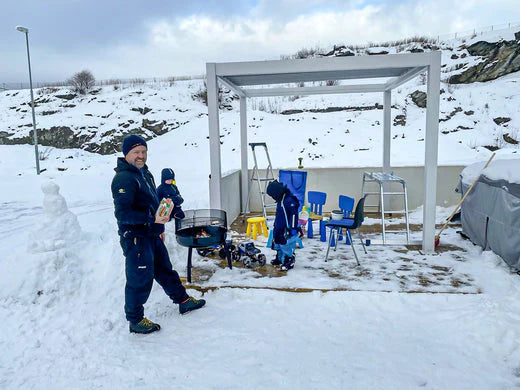Snow load: What can your patio roof withstand?

Winter can bring many things with it, both joys and a certain amount of snow for your patio roof.
The nice things undoubtedly include being able to finally enjoy warm tea and hot chocolate again, or go sledding and skiing, build snowmen or simply go for a walk in the snowy forest.
The houses also look wonderfully decorated when the snow adorns them. But this again brings the issue of snow load on your patio roof to the fore. Snow loads that are not sufficiently taken into account pose risks that can lead to potential damage. That's why you'll find out here how to prepare for the snow load on your patio roof and what you need to consider.
What is the snow load for your roof?
The snow load is the force with which a mass of snow acts on a surface. This force is directed perpendicular to the base surface. However, the snow load that your patio roof has to bear is not the same everywhere and always.
Important factors that determine this surface load are both the amount and density of snow. The snow load for your patio roof is measured and stated either in pounds per square foot (psf) or in pounds per square inch (psi).
Many people underestimate the support power that comes with enough snow. It is therefore important to find out about local regulations in order to ensure a suitable and safe patio roof - on the one hand for the safety of your roof, on the other hand to avoid costly repairs or even a complete new construction.

How the type of snow affects the load capacity
Although a single snowflake only weighs around 4 mg, the situation is different for an entire snowpack, which can Weighs 1.87 to 31.2 lb per cubic foot. Water is heavy and snow, being a frozen version, is heavy too.
However, not all snow is the same: different types have different effects on the snow load. Powder snow, which is light and fluffy, weighs less than wet or sticky snow, which has a higher moisture content and therefore greater density.
The age of the snow is also taken into account here, because older snow has a higher chance of compacting and thus creating a higher snow load for your patio roof. This fact also means that increased snowfall over several days can also lead to very different layers on your surfaces - all with their own characteristics.
Although you don't need to know these aspects in detail yourself, you should keep an eye on the snow load on your patio roof. An additional, more important help if you have your Pergola prepare for snow load, or the carport, are the snow load zones.
Why you should know your snow load zone for your patio roof
With the snow load zones, the exact calculation has already been done for you and you have an orientation as to the minimum snow load your terrace roof has to be able to cope with.
The snow load zones in Europe are defined according to the European standard DIN EN 1991-1-3 “Eurocode 1: Effects on structures - Part 1-3: General effects - snow loads” and range from zones 1 to 3.
By default, Zone 1 expects the lightest snowfall and Zone 3 the heaviest, with the values breaking down as follows:
- Zone 1 ≥ 13.58 psf
- Zone 1a ≥ 16.91 psf
- Zone 2 ≥ 17.75 psf
- Zone 2a ≥ 22.13 psf
- Zone 3 ≥ 22.97 psf
This division is used when building houses, yours Winter garden, yours Glass patio cover and much more taken into account. When purchasing, you will also be informed of the following: Manufacturers specify the zone values on their products for this snow load on your patio roof. This means you have a maximum value for the product and can also compare this with a map of the snow load zones.

How can you influence the snow load on your patio roof?
There's nothing you can do about the snow - especially if it's unusually heavy. However, you can reduce the snow load on your patio cover by taking a few aspects into account or strengthening them when purchasing and building it.
-
Material:
Whether wood, aluminum or steel, every material has a different weight and different load-bearing capacities and properties - especially in the cold. These must be taken into account when making the selection, but can also be partially compensated for with other factors.
-
Construction:
This does not just mean the patio roof itself when there is snow load. Your construction will also become more robust with additional support pillars or reinforcements, which can increase its load capacity. With Pergolux's expert service and selection, you will always receive patio coverings that are stabilized for snow loads.
-
Area size and angle of inclination:
The more area you offer, the greater the snow load on your patio roof. A flat roof therefore has to carry a higher snow load than a roof with an angle of inclination: the snow cannot slide off more quickly. A sloped roof also has a smaller footprint.
-
Maintenance:
Remove snow regularly before it accumulates too much. In this way you reduce the snow load on your patio roof and extend the life of your roof.
Ensure quality and durability: If there is a high snow load, buy your patio roof from Pergolux!
To ensure that the snow load doesn't ruin your patio roof, buy your patio roof from PERGOLUX!
With us you have an experienced, expert and specialized partner at your side when you can prepare your patio roof for snow loads. We offer you high-quality, modern and elegant Pergola-Pavilion that fit every style and can be adapted to your wishes.
Our expert service will support you from the beginning to the end of your project: We will advise you individually to find the best solution for your needs and build your patio roof, even with high snow loads.
FAQ
How many sides must be open on a carport?
In the United States, a carport usually has to have at least two sides open. This requirement is often made by the building regulations of the federal states in order to classify the carport as an “open” structure. The reason for this is that a carport is treated differently under building law than a closed garage due to its open design. However, the exact regulations may vary by state and municipality, so you should contact your local building authority or building authority for specific regulations.
How close can you place a carport to the property line?
In the United States, a carport can in many cases be built directly on the property boundary if certain conditions are met, such as a maximum length of 9 meters and a height of up to 3 meters. However, the exact regulations vary by state, and it may be necessary to apply for a building permit or obtain neighbor's consent. It is advisable to contact the local building control authority to find out the exact distance regulations and legal requirements.
How far does a carport have to be from the house? There is no nationwide uniform regulation in the United States that stipulates how far a carport must be from the house. In practice, the distance is often determined by local building regulations or fire safety requirements. In principle, a carport can also be attached directly to the house as long as building regulations and fire protection regulations are adhered to, which is why consultation with the responsible authority is recommended.
Would you like to find out more about other blog posts?


